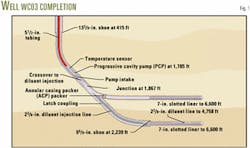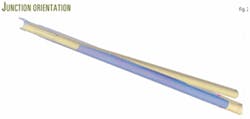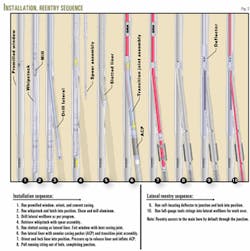A new premilled window system provides another option for completing multilateral wells in the Orinoco heavy oil projects in Venezuela.
Sincor, one of four joint ventures in the area, installed the prototype TAML (Technology Advancement for Multilaterals) Level 3 system in its WC03 well.
Advantages to this type of completion include:
- No need to mill the casing.
- A controlled premilled window geometry.
- Easy whipstock retrieval.
- Large ID through junction.
- Lateral annular casing packer (ACP) close to the junction.
- Three-trip installation.
- Reduced installation time.
The installation did encounter the limitations of sand entering the main bore after the completion, tight locking collet tolerances inside the wear bushing, and overly complicated assembly of the liner and junction on the rig floor.
Sincor's plans for future wells with this system are unclear because its current wells provide the production levels required for its upgrader, and it will not require drilling new wells to maintain crude production levels until 2004.
New system
Sincor sponsored the prototype installation of Halliburton Energy Services' Sperry-Sun product-service line multilateral system because it needed a competitive TAML Level 3 junction that could be effectively installed in the heavy oil sands of its Orinoco development.
Sincor has become highly proficient at implementing multilateral well designs, and it routinely installs Levels 3 and 4 multilaterals to obtain more than 8,000 ft of horizontal reservoir drainage per well.
The company installed Sperry Suns new MachRite system with a 95/8-in. premilled casing window at 66º inclination, at a relatively shallow 1,800-ft depth (Fig. 1).
The completion has a 4,000-ft long, 7-in. slotted liner that was run with a hydraulic-release liner running tool. The liner includes an 8-ft annular casing packer (ACP) positioned just below the precut transition joint.
The transition joint locks into the 95/8-in. window joint to connect the lateral liner to the main casing. Careful engineering of the transition joint and the premilled casing window left a gap exposed to the formation of just a little more than 1/8-in.
This small gap combined with the lateral ACP minimizes sand influx into the junction.
Measurement-while-drilling (MWD) tools surveyed and oriented on depth the transition tool to line up within 2° of the premilled window orientation.
This completion provides unrestricted access to both legs of the well, and a self-locating deflector allows easy re-entry to the lateral.
This prototype installation went smoothly. It took less than 6 hr to assemble, run, orient, set, and release the liner. A swab-cup tool connected below the liner running tool was used to inflate the lateral ACP.
The construction time was less than 20 hr for the dedicated multilateral junction. This construction time may be possibly the world's fastest for a Level 3 multilateral system to date.
Orinoco syncrude
The Sincor project is one of four joint ventures headed by Venezuela's state oil company Petróleos de Venezuela SA (PDVSA) for developing extra-heavy crude oil reservoirs of the Orinoco region of central Venezuela.
Estimates indicate that the area has about 100-270 billion bbl of recoverable reserves of bitumen and extra-heavy crude oil. Currently PDVSA and its foreign investment partners produce and upgrade about 450,000 bo/d.
The upgrading process changes the heavy crude to more-valuable synthetic crude (syncrude) products.
Sincor is a $4.2-billion project funded through a partnership between PDVSA and two international oil companies: Total SA and Statoil AS.
Since starting production in February 2002, Sincor has been producing between 140,000 and 160,000 bo/d with a peak capacity of up to 200,000 bo/d. The project produces 9º gravity extra-heavy crude from a 19-sq mile sector in the Zuata crude production area in the state of Anzoategui in eastern Venezuela.
The crude then moves by pipeline to the Jose industrial complex, on the coast of Venezuela, where a delayed-coking process upgrades the crude into a 32º gravity syncrude.
Several processes remove contaminants and produce what is believed to be the highest quality light crude from the Orinoco region. The syncrude has less than 0.1% sulfur and no metals and is available in the Zuata Sweet grade.
Drilling from pads minimizes environmental impact and improves the economics of both drilling and production facilities. Each pad typically has 10-12 horizontal wells drilled out in about a 5,000 ft radius around the pad.
Because physical constraints limit the number of wells on a drilling pad, Sincor often drills multilateral wells to maximize reservoir drainage of a well, thereby increasing production rates and ultimate recovery.
A conventional well in this area will have about 4,000 ft of horizontal reservoir exposure into which the heavy, viscous crude oil can flow.
A dual-leg multilateral well easily can double this amount of reservoir exposure without requiring any additional surface facilities.
Sincor's specific objectives for using multilaterals are as follows:
- Increase the production rate per well.
- Increase and accelerate the reservoir recovery factor.
- Lessen the environmental impact by reducing the number of drilling slots and amount of drilling fluid needed.
- Reduce well-construction costs by needing fewer wellheads and less production equipment.
Through their experience, Sincor has proven conclusively that multilateral technology reduces development costs, increases well production rates, and increases reserves recovery by improving the reservoir exposure to the wellbore.
Compared to a single well, a multilateral well will increase the recovery factor by improving the sweep efficiency.
The most important benefit of this technology is that the development cost per incremental barrel of reserves is less for a multilateral well than for drilling a second horizontal well.
Well design
One major concern regarding multilateral wells in the Orinoco belt is junction stability because the junction must be placed within the reservoir that is composed of intermittently shaly sand beds up to 200-ft thick.
It can be very challenging to construct a junction that will remain competent within these unconsolidated sands and soft shales.
Also drawdown pressures frequently put stresses on the junction and cause sand influx.
Slotted liners exclude most of the formation sand from entering the wellbore, but incidences of plugged liners, sanded-in junctions, and damaged pumps, however, remain common operational concerns.
Placement of the multilateral junction in unconsolidated sands that have little inherent compressive strength precludes the use of an unsupported junction. Levels 1 or 2 junctions would likely collapse because they are left open and exposed to production pressures and flow. Comparatively, these wells have low pressure and the production is universally commingled, thus eliminating the need to install a complex Level 5 completion in the wells.
To date, Level 6 technology has not been proven economical or practical for shallow, heavy oil applications.
The junction-selection process has led to the widespread use of Levels 3 and 4 multilateral junctions in the Orinoco region. Level 3 junctions are completely lined and connected to the mother bore that mechanically supports the junction.
The Level 4 solution involves a completely lined lateral wellbore that is cemented in place to secure and seal the junction. Although the cement is not technically a sealing mechanism, it does prevent the annular migration of formation sand around the junction.
Sincor has used a combination of multilateral systems to maximize the productivity of the Zuata development. The decision to use a Level 3 or 4 system is made on an individual well basis after analysis of the specific geology in a well.
Typically Level 3 systems are reserved for wells in which the junction can be placed in competent shale because the shale zones are less permeable and have a higher compressive strength.
To date, Sincor has installed nine Level 3 and four Level 4 multilateral systems.
The latest Level 3 system installation included the MachRite multilateral system to create an improved junction (Fig. 2).
The well design called for a system that suited the following requirements:
- Dual planar wells (two horizontal laterals in the same reservoir).
- Both laterals to be drilled with 81/2 in. polycrystalline-diamond compact (PDC) bits.
- Both laterals to be completed with a 7 in., 23 lb/ft, J-55 slotted liner.
- A string of 95/8 in., 40 lb/ft, J-55 main bore casing for lateral exit.
- Progressive cavity pump (PCP) to be set in the tangent section of the 95/8-in. casing.
- Multilateral junction architecture applicable to stacked junction placement for accessing multiple targets.
- Selective reentry of individual laterals for clean out or stimulation.
Installation of a 95/8 in. premilled window joint in the main bore casing string facilitated the junction construction operations. The premilled window is simply a standard joint of 95/8 in. casing with a machine cutout for the exit profile.
The exit opening is then wrapped inside a thick shroud of aluminum to contain circulating and cementing pressures. The aluminum holds pressures up to 3,000 psi while still being very easy to mill through at the casing exit point.
On this job, the window assembly was run between normal joints of casing spaced out to be landed at the junction depth of 1,800 ft.
Premilled windows must be oriented to within ±30º of the high side (a vertical gravity toolface) for proper drill out and completion. This is accomplished by turning the casing string at surface based on the information from a wireline tool run inside the casing. The tool contains a gyroscopic survey instrument that relays the orientation of the window to surface.
Under normal circumstances, torque and drag in the wellbore do not complicate the process of orienting a premilled window.
In well WC03, the premilled window was oriented and surveyed to 13º left of high side, or 13º counterclockwise from vertical prior to the 95/8-in. casing string being cemented in place following normal procedures.
The premilled window assembly primarily serves as a casing exit point of the multilateral junction. It, however, includes a number of additional features to facilitate junction construction.
The most important feature is the latch coupling. Patented in the early 1990s, the latch coupling is the anchoring device for all Sperry-Sun multilateral systems. The latch allows drilling whipstocks, deflectors, and completion equipment to be reliably and repeatedly landed into the latch coupling throughout the life of the well.
The latch coupling is an integral part of the premilled window assembly, and it is located just below the window aperture. Latch couplings are full gauge and do not restrict casing ID.
The premilled window system for constructing the multilateral junction allows for the permanent depth and orientation platform to be automatically installed via the latch coupling.
Some conventional milled-casing exit systems also can provide this feature, but in these systems, it involves the installation of a permanent packer to provide the anchor point in the main casing. Other milled exit systems require a primitive cement plug to set the milling whipstocks.
Conventional casing milling systems can take as much as 10 hr to mill a window, depending on the grade and weight of the casing. The resulting geometry of this milled casing window may not always be straight.
Mills often roll to one side or "jump" out of the casing as they progress along the whipstock face. This can create a shorter casing window than required for Levels 3 or 4 multilateral junctions.
The rolling effect of mills can create a curved window that is difficult to re-enter.
Another problem with simply milling a hole in the casing to construct a multilateral junction is the milling debris that is created. Steel cuttings can be very difficult to circulate out of the hole and can accumulate in the wellbore causing problems for future tool runs.
The aluminum wrap, on the other hand, has very light, soft cuttings that do not cause problems in the well.
One feature of the MachRite system is the incorporated locking profile in the upper window coupling that anchors the lateral casing. This profile works like a no-go landing profile for the casing. It locates and locks the lateral liner in position relative to the premilled window.
The controlled geometry of the premilled window allows for tighter tolerances within the junction geometry. The system uses a very large OD transition joint to minimize the ID restriction through the junction. It requires a high degree of confidence in the premilled window geometry to lock the 83/8-in. OD transition joint through the 81/2-in. casing exit.
It would not be recommended to run this size of tubular through a conventionally milled casing window.
The premilled window systems allows for easy casing exits, controlled window geometry, tighter window tolerances, and the installation of the permanent latch coupling in the well.
WC03 completion
The junction is essentially complete once the liner is landed and the lock collet is fixed into the casing.
Part of Sincor's requirements for the Well WC03 was to have an annular casing packer (ACP) installed as close as possible to the junction. It required the ACP for isolation to stop the migration of sand particles through the liner annulus and into the junction.
Setting the ACP involved first inflating it as soon as the liner was landed and without any extra trips into the hole. Pressurizing the ACP to energize its elements was done through an inner string that was connected to an inflation tool.
Production data over time will tell how well the packer isolates the liner annulus from sand migration.
The final part in completing WC03 was the placement of a progressive cavity pump at 1,785 ft, just above the multilateral junction, and strapping in 51/2-in. production tubing with a sensor cable to monitor pressure and temperature just above the pump. A 1.66-in. diluent injection line was run alongside the tubing. Diluent reduces the crude viscosity before the pump intake.
During the completion, some sand accumulation was found below the junction. It is probable that the sand moved into the main wellbore as a result of the liner installation process. A tubing workstring prior to completing the well circulated the sand out of the hole, and to date no evidence of sand production has been found in WC03.
The well is not yet on production, but estimates indicate that the well will produce up to 2,000 bo/d. This rate is about 80% higher than the average production rate of a single horizontal well on this pad.
A reentry deflector tool will be provided to access the lateral wellbore if the well requires a future workover.
One runs the deflector to the top of the transition joint where it self-locates and locks into place. It self-orients to face the lateral wellbore via matching muleshoe profiles that turn the assembly as it is landed.
A hydraulic running tool (HRT) that actuates with circulation pressure runs and retrieves the deflector. Conventional full-gauge tools can be used for cleaning out or stimulation operations in the lateral.
Reentry access to the lateral wellbore is full gauge to facilitate cleanout or stimulation operations.
Fig. 3 shows the installation and lateral reentry sequence.
The authors
Steven R. Fipke is a multilateral project engineer for Halliburton - Sperry-Sun in Nisku, Canada. He is primarily responsible for the development and support of new multilateral drilling and completion technology at Sperry-Sun's global multilateral headquarters. Fipke holds a BS in petroleum engineering from the University of Alberta.
Vilma Guzmán Bernard is a monitoring reservoir engineer for Sincor in Caracas. She previous worked with the drilling team and was in charge of multilateral wells drilled during Sincor's first drilling campaign. Guzmán holds a degree in petroleum engineering from the University Central of Venezuela.





